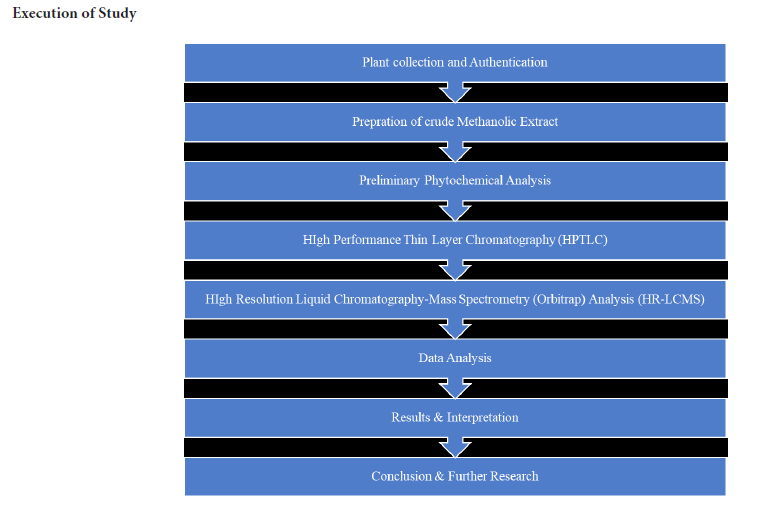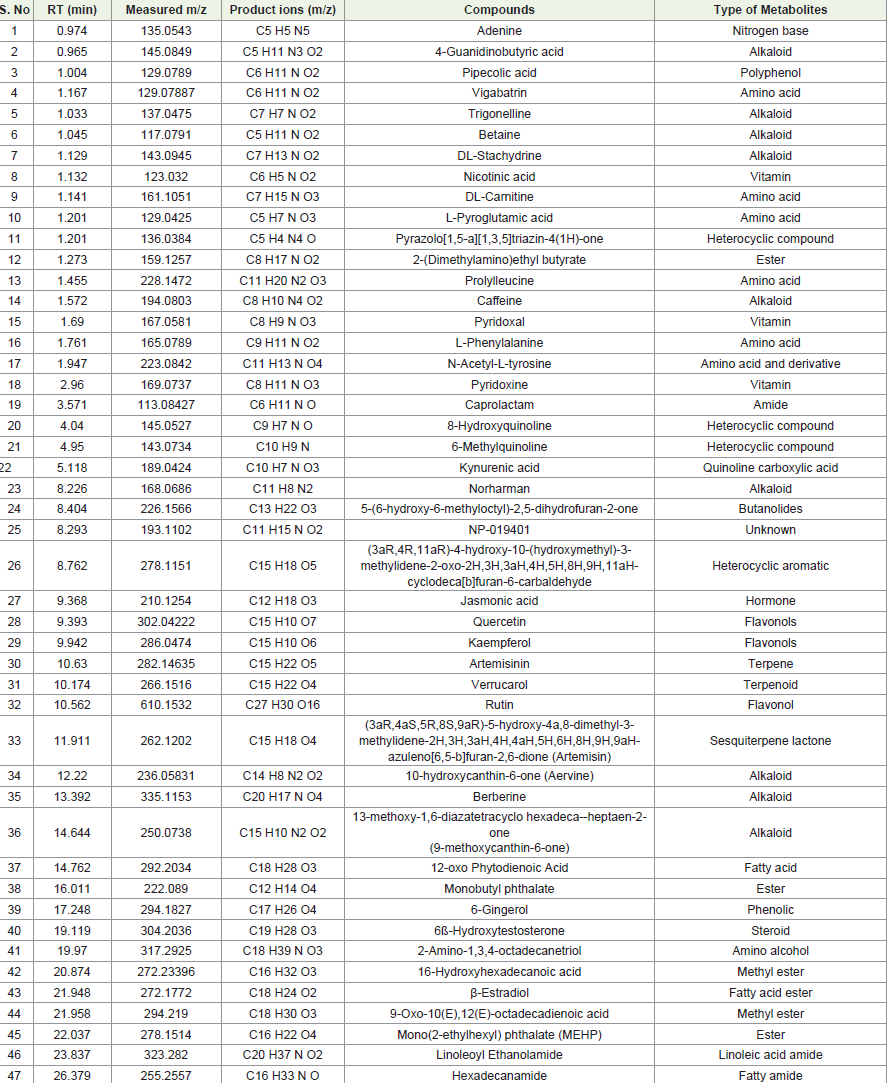Research Article
HPTLC and HR-LCMS Phytochemical Analysis of Methanolic Extract of Aerva lanata
Trivedi S1*, Jain N2, and Rawal R2
1Department of Biochemistry, Gujarat University, Ahmedabad, Gujarat, India
2Department of Life Sciences, Food and Nutrition Science, Gujarat University, Ahmedabad, Gujarat, India
*Corresponding author:Trivedi S, Department of Biochemistry, Gujarat University, Ahmedabad, Gujarat, India. Email: savitri_trivedi@yahoo.com
Copyright: ©Trivedi S, et al. 2024. This is an open access article distributed under the Creative Commons Attribution License, which permits unrestricted use, distribution, and reproduction in any medium, provided the original work is properly cited.
Article Information:Submission: 20/05/2024; Accepted: 13/06/2024; Published: 18/06/2024
Abstract
Medicinal plants are a gift to humankind as they play a significant role in preserving, maintaining, and improving our health. Aerva lanata has been known for decades for its various pharmacological activities. Despite extensive research on its medicinal properties, there have been limited studies focusing on
its hepatoprotective activity. This study aims to explore the bioactive components of Aerva lanata and investigate its potential hepatoprotective properties. The review utilized various scientific databases, including PubMed and ScienceDirect, to gather information on the pharmacological activities and bioactive
components of Aerva lanata. The whole plant methanolic extract of Aerva lanata was subjected to preliminary phytochemical analysis, revealing the presence of alkaloids, flavonoids, phenols, glycosides, and tannins. High-Performance Thin-Layer Chromatography (HPTLC) was used to identify prominent
compounds, followed by High Resolution Liquid Chromatography-Mass Spectrometry Orbitrap (HR-LCMS, Orbitrap) for detailed component analysis. The HPTLC chromatogram indicated significant spots at Rf values of 0.026, 0.075, 0.096, 0.46, and 0.82. HR-LCMS analysis revealed several medicinally
important compounds, including norharman, 10-hydroxycanthin-6-one, 9-methoxycanthin-6-one, trigonelline, methylquinoline, 8-hydroxyquinoline, quercetin, kaempferol, rutin, and artemisinin. These findings support the traditional uses of Aerva lanata and suggest the potential for new drug discoveries. The study concludes that Aerva lanata contains several bioactive compounds with medicinal properties, justifying its traditional applications. Further research is needed to fully understand its hepatoprotective mechanisms and explore new therapeutic possibilities.
Keywords:Aerva lanata; HR-LCMS; Hepatoprotective; Medicinal Plants; Phytochemicals
Introduction
Aerva lanata (A. lanata) is a well-known medicinal plant
belonging to the family Amaranthaceae which is found all over
India as a common weed [1]. It is native to Africa, tropical Asia,
Madagascar and Saudi Arabia [2]. A. lanata is named differently in
different regions of India like Chhaya in West Bengal, Gorakhganja
in Gujarat,Pindidonda in Telugu, Buikallan in Punjab, Bhuyi in
Rajasthan, Ulinai in Tamiland Paunsia in Odissa [3]. It is known to
contain various alkaloids, flavonoids, proteins, amino acids, quinones
and carbohydrates in different solvent extracts [4]. In recent years, it
has gained prominent importance in the field of medicine because
of its different pharmacological properties. Numerous studies on
its extraction ingredients from different plant parts reported its
antidiuretic [5], antimicrobial [6,7], hepatoprotective [8], antiinflammatory,
anti-helminthic [9], anti-HIV [10] anti-cancerous [11-12], anti-diarrheal [13], anti-urolithiatic [14], hypolipidemic[15], nephroprotective [16], analgesic [17], antidiabetic [18] and antiasthmatic
activity [19].
Herbal ingredients are promising choice as medicines in
Ayurveda and Unani treatment since ancient times because of fewer
side effects and low costs [20,21]. The potential bioactive compounds
from plant were isolated and selected based on the phytochemical,
taxonomic and ethnomedicinal approach [22]. A. lanata is a gift from
nature because it possesses plentiful healing properties [2,23]. It
has been observed that A. lanata has been used traditionally to treat
common ailments like headache, burns, jaundice, cholera, measles,
gall stones, diarrhea, cough and bronchitis, snake bites, arthritis [9].
Only few studies in literature evaluated significant hepatoprotective
activity of A. lanata [8,24,25]. In the present study, an attempt is
made to explore the biological components of A. lanata and zooming
on few components which can be the potential active components
possessing hepatoprotective activity.
Materials and Methods
A. lanata was collected from natural habitats, Godhra, Gujarat,
India. Plant authenticated by Dr. Bharat Maitreya (Professor,
Department of Botany, Bioinformatics and Climate Change Impact
Management, Gujarat University). The specimens collected was
deposited for reference (No. GU/BOT/A/A21) at the herbarium,
Gujarati University. The extraction of active ingredients from
different parts of A. lanata was prepared using standard hot and
dried methodology. Accurately Weighed 1gm of dried plant material
was transferred to a 250 ml volumetric flask dissolving in 100 ml
of solvent and kept on hot plate for 5 hours at 70 °C. The process
was repeated until the solution become colorless. The content of the
flask was filtered through Whatman No.1 paper (Merck, Mumbai,
India). The residue was dried, concentrated and stored in desiccator
for further analysis. The qualitative phytochemical analysis was
carried out using standardized tests to identify polyphenols, tannins,
flavonoids, steroids, alkaloids, saponins, terpenoids etc. [26].
HPTLC:
An HPTLC system is equipped with a TLC scanner 3, Linomat
V sample applicator and CATS V 4.06 software. All the solvents
and chemicals procured were of HPTLC grade (Merck, Mumbai,
India. The sample extract was prepared in 90% ethanol. The sample
was applied as bands of 0.2 mm eachby CamagLinomat V sample
applicator (Muttenz, Switzerland) equipped with 100 μl Hamilton
syringe on 20 cm * 10 cm aluminum plates coated with silica gel 60F254
(Merck, Mumbai, India). Ascending development was performed at
room temperature with Toluene: Ethyl acetate solution in ration of
9:1 (v/v) as a mobile phase in a Camag glass twin-trough chamber
saturated with mobile phase vapor for 30 mins prior. The developed
plates were air dried and scanned at 366 nm with a Camag TLC
scanner with CATS V4.06 software, using deuterium lamp.High Resolution Liquid chromatography-mass spectrometry (HR-LCMS) characterization:
HR-LCMS was done to determine the bioactive compounds
present in methanolic extract of A. lanata. The LC system consist of
two pumps and an automated injector. Separation of components
achieved in Syncronis C-18 column (Size: 5 μm, 100 mm x 4.6 mm)
(Thermo Fisher Scientific, Massachusetts, USA). Before analysis, the
sample was prepared by centrifuging at 12000 rpm for 10 mins. The
separated components enter into QExactive Hybrid Quadrupole-
Orbitrap mass spectrometer (Thermo Fisher Scientific, Massachusetts,
USA) equipped with an electrospray ionization interface (ESI). This
system has Xcalibur,Version 4.2.28.14 data acquisition software.
Two mobile phases; A-0.1% formic acid in Milli-Q water and DAcetonitrile
in Milli-Q water were used as mobile phase at a flow rate
of 500 μl min−1.Results
The present study was designed to evaluate the phytochemical
screening and HR-LCMS analysis of the crude methanolic extract
fraction of A. lanata. In plant extraction process, the percentage
yield of aqueous and methanolic extract of A. lanata whole plant was
obtained 5.5% and 5.2%, for leaves 4.2% and 2.7%, for stem 2.5%
and 3.7%, and for flower 3.4% and 2.9% w/w, respectively.(Table
2) showed the preliminary qualitative phytochemical analysis of
methanolic extract of A. lanata and its plant parts, which confirm the
presence of Alkaloids, carbohydrates, glycosides, phenols, protein,
amino acids, and flavonoids in whole plant extract. Numerous
solvent compositions were tested for HPTLC analysis, from which
Toluene: Ethyl acetate (v/v) gave the desired aim results. HPTLC
chromatogramof whole plant methanolic extract of A. lanata
determined high resolution and reproducible peaks under 366 nm,
which revealed the presence of five prominent bands with Rf value
ranged from 0.026-0.82 [Figure 1].
HR-LCMS analysis of methanolic extract of A. lanata lead to the
identification of 47 bioactive compounds at different retention time
that could attribute towards the pharmacological properties (Table
3). The big molecules fragments into small compounds giving rise to
appearance of peaks at different m/z ratio. We have identified these
components by comparing with the authentic m/z spectra available
in HR-LCMS data library. These identified components correspond
to 80 % of the chromatogram [Figure 2]. The first predominant peak
observed with less retention time 0.97 was identified as Adenine
whereas Hexadecanamide was the last compound identified which
took longest retention time 26.37. HR-LCMS data of A. lanata
confirms that it comprises of active alkaloids such as Norharman,
aervine (10-hydroxycanthin-6-one), 9-methoxycanthin-6-one and
Trigonelline. The heterocyclic compounds such as 6-Methylquinoline
and 8-Hydroxyquinoline also been observed. A. lanata comprises of
flavanols like Quercetin and Kaempferol [Table 3]. This plant also
has flavonoid glucoside named rutin and artemisinin which is a
terpene. Additionally, we have identified carbohydrates, few phenolic
compounds, and amino acids like phenyl alanine and tyrosine.
Discussion
Phytochemicals play vital role in treating various diseases and are
still used in modern medicine. The identification of new constituents
is not only important for therapeutic agents but also helps in finding
new economically important components like oil, saponins, tannins,
flavonoids, gums etc. [27-29]. Nowadays it becomes easier with
different methods to isolate and identify the bioactive compounds
present in plant. Hot and dried method of plant extraction is very
old method. Among 28 species of Aerva genus, only three species
A. lanata, A. javanica, A. persica are known to have the medicinal
properties [30].
The results of the present preliminary study on A.lanata’s
whole plant methanolic extract evidenced the presence of alkaloids,
flavonoids, phenols, terpenes and glycosides. Thus, this shows that
whole plant extract prepared using methanol as a solvent had the
maximum bioactive compounds. These phytoconstituents could
be responsible for the medicinal properties of A.lanata [31-33].
Hence, for further confirmation of these different-phytoconstituents,
we conducted HR-LCMS analysis for the methanolic whole plant
extract. The obtained biological molecules in methanolic extract
have therapeutic values. The hexadecanoic acid, which is methyl
ester of palmitic acid, is already known for its anti-oxidant, hypocholesterolemic,
antis-androgenic, hemolytic, and 5-Alpha-reductase
inhibitor and pesticide activity [34]. Alkaloids are known for their
role in plant defense system against pathogenic organisms. Similarly,
A. lanata also contains many alkaloids like 10-hydroxycanthin-6-
one (Aervine), 13-methoxy-1,6-diazatetracyclo hexadeca-heptaen-
2-one, and Betaine. Presence of aervine, 9-methoxycanthin-6-one
and β-carboline-like alkaloid has also been reported previously [35,36]. The compound 9-Oxo-10(E),12(E)-octadecadienoic acidfound
in A. lanata as a significant role in prostaglandin biosynthesis and
possesses other biological activities such as anti-inflammatory, antiarthritic
and hepatoprotective [37,38]. A previous study showed
that A. lanata hydroalcoholic extract was effective in protecting liver
damage in rats caused by paracetamol [8,24]. Rutin, a flavanol, is
known for its anti-inflammatory, anti-cancerous, neuro-protective,
cardio protective and anti-oxidative activity [39,40]. One of the
studies confirmed the hepatoprotective activity of alkaloid present in
petroleum ether extract of A. lanata [12]. Considering the presence of
different biologically active compounds in the methanolic extract of
A. lanata, few compounds can be chosen for bioinformatic studies to
select the best molecule which could be studied further in-vitro and
in-vivo for hepatoprotective activity.
Figure 2:Chromatographic profile of (LC-ESI-MS/MS) of whole plant methanolic extract of A. lanata in both ESI (+) and ESI (-) ionization modes
Conclusion
The developed HPTLC profile revealed fingerprint of
phytochemicals present in A. lanata and confirming the purity and
identity of the species. HR-LCMS revealed the presence of many
diverse bioactive components which justifies the use of whole plant
extract for treating different diseases in older times. However, a new
area of research will open if isolation and identification of novel
pharmacologically active compounds is conducted done. Further,
Invitro and in-vivo study is needed to prove the hepatoprotective
activity of those phytoconstituents present in A. lanata.






